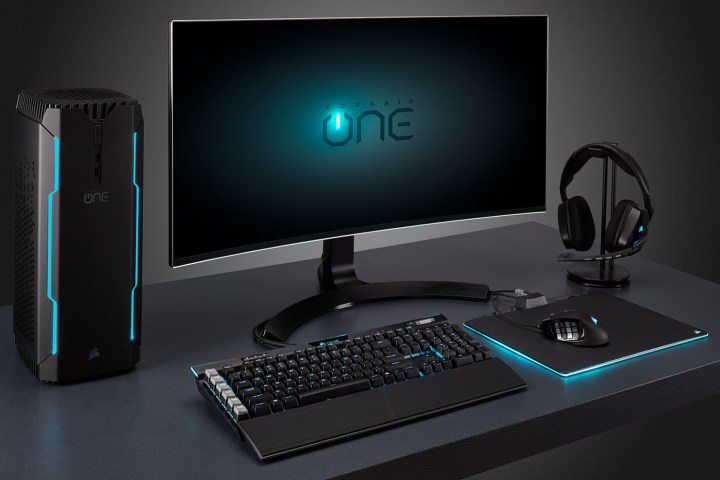
Here are all seven available desktops:
| CPU | GPU | Memory (two slots) |
Storage | Power Supply | |
| $1,800 | i7-7700 | GTX 1070 | 16GB DDR4 @ 2,400MHz |
240GB SSD 1TB HDD |
400 watt 80 Plus Gold |
| $2,200 | i7-7700K | GTX 1080 | 16GB DDR4 @ 2,400MHz |
480GB SSD 2TB HDD |
400 watt 80 Plus Gold |
| $2,300 | i7-7700K | GTX 1080 | 16GB DDR4 @ 2,400MHz |
960GB SSD | 400 watt 80 Plus Gold |
| $2,600 | i7-7700K | GTX 1080 Ti | 16GB DDR4 @ 2,400MHz |
960GB SSD | 500 watt 80 Plus Gold |
| $2,300* | i7-7700K | GTX 1080 | 16GB DDR4 @ 2,400MHz |
480GB M.2 SSD 2TB HDD |
400 watt 80 Plus Gold |
| $2,700* | i7-7700K | GTX 1080 Ti | 16GB DDR4 @ 2,400MHz |
480GB M.2 SSD 2TB HDD |
500 watt 80 Plus Gold |
| $2,900* | i7-7700K | GTX 1080 Ti | 32GB DDR4 @ 2,400MHz |
480GB M.2 SSD 2TB HDD |
500 watt 80 Plus Gold |
* New configurations
The memory used in Corsair’s PC gaming desktops is based on the company’s Vengeance LPX DDR4 sticks. Designed for overclocking, these memory modules include a heatspreader made from pure aluminum to keep those circuits running optimally, and a printed circuit board designed to properly manage the heat. On their own, Corsair’s 16GB kit running at 2,400MHz can cost $170 while the 32GB kit can cost $300.
Meanwhile, product images show that the Corsair One desktops rely on the company’s own SF400 and SF500 power supplies, which are underpowered based on Nvidia’s suggestions for its GTX 1080 and GTX 1080 Ti cards. For the GTX 1080 Ti graphics chip, Nvidia suggests the use of a 600-watt power supply given that the card consumes 250 watts on its own. For the vanilla GTX 1080 card, Nvidia suggests a 500-watt power supply (180-watt usage). That said, there doesn’t appear to be any way to choose a better power supply option for Corsair’s desktops.
“The sleek, aircraft-grade aluminum chassis is built with painstaking attention to detail, and extremely resistant to surface wear,” the company states. “Featuring a previously impossible small footprint, and subtle ambient lighting details, Corsair One is at home in any environment.”
As for the rest of the specifications, the desktops provide these features:
| Ports (back): | 1x PS/2 Port 2x USB 3.1 Gen1 Type-A 3x USB 3.1 Gen2 Type-A 1x USB 3.1 Gen2 Type-C 1x Gigabit Ethernet 1x HDMI 2x DisplayPort 5x Audio jacks 2x Wi-Fi antenna jacks 1x S/PDIF audio |
| Ports (front): | 1x HDMI 2.0 1x USB 3.1 Gen1 Type-A |
| Connectivity: | Wireless AC Bluetooth 4.2 |
| Form factor: | Mini-Tower |
| CPU cooling: | Liquid |
| GPU cooling: | Liquid |
| Dimensions: | 7.87 x 6.92 x 14.96 inches |
| Weight: | 16.31 pounds |
| Case materials: | Steel Bead-blasted aluminum |
| Case color: | Black |
As the base specifications show, Corsair’s desktop provides an HDMI port and a USB 3.1 Gen1 Type-A port on the front for easy virtual reality headset connectivity (although for the HTC Vive, you’re better off connecting the link box to the back). Both the processor and graphics card are liquid cooled, too, providing a highly quiet environment while the computer idles.



